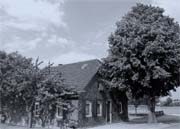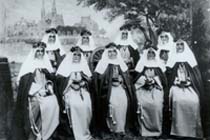 Hendrina
Stenmanns was born on May 28, 1852, in Issum, German Lower Rhineland,
the eldest of seven children. Already as a child, she showed great concern
for the poor and suffering whom she visited with her mother. She also
cared responsibly for her younger brothers and sisters. After leaving
school, she contributed to the family income through her work as a silk
weaver. The characteristics for which she was noted, a motherly and cheerful
nature, kindness and a healing compassion, began to show in the young
Hendrina. She always managed to find the sick and needy, and people turned
to her for help and advice in all their problems. Without her being aware
of it, God was developing the character and talents she would need for
her future tasks.
Hendrina
Stenmanns was born on May 28, 1852, in Issum, German Lower Rhineland,
the eldest of seven children. Already as a child, she showed great concern
for the poor and suffering whom she visited with her mother. She also
cared responsibly for her younger brothers and sisters. After leaving
school, she contributed to the family income through her work as a silk
weaver. The characteristics for which she was noted, a motherly and cheerful
nature, kindness and a healing compassion, began to show in the young
Hendrina. She always managed to find the sick and needy, and people turned
to her for help and advice in all their problems. Without her being aware
of it, God was developing the character and talents she would need for
her future tasks.
When she was 19, she joined the Franciscan Third Order. That fertile soil nourished in her a spirit of great simplicity both in her prayer life and her dealings with others, as well as trust in God and the readiness to give herself entirely. Her wish to consecrate herself to God grew more as she absorbed the spirit of St. Francis, but the Kulturkampf in Germany made religious life impossible. When her mother was dying, Hendrina promised to care for her younger brothers and sisters. It began to look as though she would have to give up the idea of religious life.
Some years later, through an apprentice of her father, she found her way to Steyl and asked Arnold Janssen to accept her into the Mission House as a kitchen maid. Her real intention, however, was to support the mission cause by her work in the kitchen. When she arrived in Steyl, she was almost 32 years old, matured by the history of her family and her neighborhood. Her letter to Arnold Janssen is an expression of her spirituality and her deep wish to dedicate herself totally to missionary work. She did not have great plans but simply carried out what she recognized as God’s will for her at each moment.
Through her decision to live in the Mission House as a kitchen maid, she stepped down, like her companion Helena, to the lowest rung of the social ladder. A life of hard work and renunciation began that was to last five years as she waited for the women’s foundation. On December 8, 1889, she and a few other women became postulants. The foundation of the congregation had been laid. The novitiate followed and then in March 1894 the first vows. Hendrina was given the name Josepha.
As Sr. Josepha she was responsible for the management of the practical side of things in the house. Later on she became directress of postulants. She showed great understanding of human nature and was able to introduce the young women into religious life with wisdom and empathy. The convent was opened for retreats for women, a significant apostolate that involved extra work for the sisters. Soon language studies and a teacher’s training course were established.
Sr. Josepha was known above all for her love of prayer; she progressed more and more to interior quiet and to true contemplation in the midst of her manifold tasks. The rosary, short prayers, especially “Come, Holy Spirit” became her “mantra”, leading her inward to the presence of God in the tabernacle of her heart.
When Sr. Maria transferred to the adoration sisters, Sr. Josepha became leader of the missionary sisters’ community. In spite of the burden of work and the demands made by a large, young community, she did not lose herself in pure activity. In the depth of her heart she remained in union with God and maintained her inner peace. The final months of Sr. Josepha’s life were marked by serious and painful illness. On her deathbed, suffering from asthma, she bequeathed her spiritual testament to the sisters: The very breath of a Servant of the Holy Spirit ought to be: “Come, Holy Spirit”.


